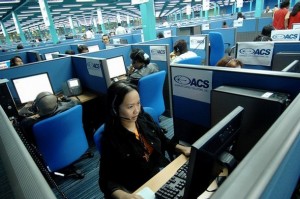In this blog post, Ashok K. K. Vasudevan, the Managing Director at Festo Global Production Centre, India and a student pursuing a Diploma in Entrepreneurship Administration and Business Laws from NUJS, Kolkata, provides structuring advice to an FMCG Company in India who wants to open a BPO in Philipines.
History Of Philippines As A Destination Country For Setting Up A BPO(1)
In the Philippines, one of the fastest growing sectors is the Information Technology – Business Process Outsourcing (IT-BPO) Industry. This aspect contributes significantly to the growth and development of Philippines.
The year 1995 was a milestone year for the Philippines when the Special Economic Zone Act, which established the Philippine Economic Zone Authority and was passed by the Philippine Congress. This Act attracted foreign investors to look keenly at the Philippines as a key destination country for setting up Business Process Outsourcing (BPO) Units. The Philippines as a country acquired over 3% of the global BPO market by the year 2005, by which time, the BPO sector accounted for 2.4% of the country’s Gross Domestic Product (GDP) which also indicated a great potential for generating employment. Only considering this sector alone, Philippines was able to provide employment to one million workers by the year 2010 and accounted for 27% of all new jobs.
Different Organizational Structures Which Are Available For Setting-Up A BPO In Philippines(2)
Different business structures can be considered for setting up a BPO in the Philippines and these different options have been listed below:
- Single/Sole Proprietorship
- Partnership
- Stock Corporation
- Branch Office
- Representative Office
- Regional Headquarters (RHQ)/Regional Operating Headquarters (ROHQ)
Pros And Cons Of The Different Organizational Structures Which Are Available For Setting Up A BPO In Philippines(2)
Single/Sole Proprietorship: This set-up is best suited for small Filipino-owned businesses. In this case, the business structure is defined by individual ownership of all assets and thereby this applies to all profits derived from the business going to the individual owner/sole proprietor. This also brings in unlimited personal liability on the shoulders of the individual owner/sole proprietor, which can also be seen as a disadvantage for this kind of business structure.
Partnership: The Partnership business structure is best suited for small to mid-sized businesses. However, this structure favors or proves advantageous to Filipino citizens, as foreigners are required to have a higher minimum capitalization requirement. This kind of business structure can be general or limited and requires registering with the Securities Exchange Commission (SEC).
Stock Corporation: A corporation can either be a stock or non-stock corporation. As their names indicate, stock corporations issue shares of stock, while non-stock corporations do not issue shares of stock. A stock corporation is a for-profit organization in which the ownership of the corporation is expressed by the shares of stock. The owner of the shares of a corporation is called a stockholder or shareholder.
The stock corporation is the most flexible business structure. A corporation is its own juridical person, and it must have at least five (5) and no more than fifteen (15) incorporators. It is mandatory to be registered with the SEC. If it is at least sixty percent Filipino-owned, then it will be considered as a Filipino corporation.
Branch Office: A branch office is considered as an extension of a foreign corporation and as such does not have its own legal personality. However, this kind of business structure can derive income from the Philippines. There is a requirement for minimum paid-up capital, which is US $ 200,000. However, this can be reduced to the US $ 100,000, if the organization is engaged in activities involving advanced technology or if it has at least 50 direct employees.
Representative Office: A Representative Office will be a foreign corporation that is governed by the laws of the country where its parent company is located. It cannot derive income from the Philippines and is fully subsidized by its head office, so only withholding taxes are required to be paid. The initial capital requirement is US $ 30,000. This is a good option for companies that want to maintain full control of their organization.
Regional Headquarters (RHQ)/Regional Operating Headquarters (ROHQ): Just as in the previous case, Regional Headquarters (RHQ) and Regional Operating Headquarters (ROHQ) are also considered as foreign entities. Whilst RHQs are not allowed to derive income from Philippine sources, and the ROHQs are allowed to derive income from the Philippines. The RHQ has a required annual capital of US $ 50,000 for operating expenses, and the ROHQ has a one-time required capital of US $ 200,000.
Advice To The FMCG Company Headquartered In Delhi For Opening A BPO In The Philippines
The previous sections elaborated on the different business structures and the pros and cons for each of these business structures for setting up a BPO in the Philippines. Before we arrive at a conclusion for choosing the best option of a business structure for the Indian company headquartered in Delhi to open a BPO in the Philippines, it is important to evaluate what kind of BPO set-up would be suitable in this case.
BPO Set-up: With reducing costs playing a significant role in the current business scenario based on the prevailing economic condition and due to lower costs of producing specific goods or services in another country, outsourcing has become a common business strategy for many multi-national firms. Typically, there are two prevailing/common practices of outsourcing, and they are:
- Third party Outsourcing
- Captive Market
Both of the above options differ with each other on the levels of risk management, cost effectiveness or the necessity for management control. In the Philippines, there are observations made that third party outsourcing is more prevalent as opposed to captive markets.
Third Party Outsourcing: The Third Party Outsourcing could either be “Project Based Outsourcing (PBO)” of having a “Dedicated Development Centre (DDC)”. In the case of PBO, it is primarily used for business activities which have irregular frequencies of work or one-off projects. The normal costing method can be adopted with time as variable costs and material costs as fixed costs. A DDC is primarily used in business cases where there are long-term goals to be achieved such as developing technology or software. This model is preferred when the resources requirements are lower in the outsourced country than in the home country and could provide a fall back option. In this case, the customers (multinational firms) are charged for fixed fees.
Captive Markets: This option is normally preferred when the core or crucial business activities are required to be run at cheaper costs. The rationale for adopting such a set-up would be to cater to long-term strategic plans and also involving high levels of managerial control. In this “Captive Markets” set-up model, the business practices and operations are still within the control of the multi-national company, which mitigates the risk of disclosure of sensitive information outside the company.
Conclusion
Based on the above inferences in different ways of setting up a BPO in the Philippines and assessing the different pros and cons, my recommendation to the Indian company headquartered in Delhi for setting up a BPO in the Philippines would be as follows:
- Adopt a “Captive Market” set-up model to establish a BPO in Philippines: Assuming that the Indian FMCG Company has the required levels of market knowledge and analytics, it can adopt a “Start from Scratch Model” whereby the company will have to develop all its resources in the Philippines. This involves the beginning of the model, which is the purchasing of property and equipment and due diligence lasts up to the point of running the BPO Centre itself. The acquisition of property and equipment could be done by connecting with a third-party liaison in the Philippines.
- The BPO of the Indian FMCG company can be set-up as a “Representative Office”: Under this set-up, it cannot derive income from the Philippines and is fully subsidized by the head office in Delhi and so only withholding taxes are required to be paid. For such a set-up, the initial capital requirement would be US S30, 000 and would also give the Indian company full control of their organization in a cost-effective manner.
As a summary, evaluating the different models and options to set-up a BPO in the Philippines, it is recommended for the Indian FMCG company which is headquartered in Delhi to establish a BPO in the Philippines by setting it up as a “Representative Office.” This warrants a minimum capital requirement as compared to another model of setting up as a “Branch Office” in the Philippines. By running it as a “Captive Centre BPO” and as a “Representative Office”, the Indian company also will be able to mitigate the risk of disclosure of sensitive information as well as maintain full control of their organization in the Philippines. This recommendation would also facilitate the general characteristic of an FMCG business with “low margins”, by keeping the costs low in running a BPO in the Philippines and with minimal investment in a captive center format, with full management control.
[divider]
References
- http://investphilippines.gov.ph
- http://businesstips.ph/
- https://en.wikepedia.org/(1)
- http://filepino.com/business-advice/(2)
- http://www.gov.ph
 Serato DJ Crack 2025Serato DJ PRO Crack
Serato DJ Crack 2025Serato DJ PRO Crack









 Allow notifications
Allow notifications



